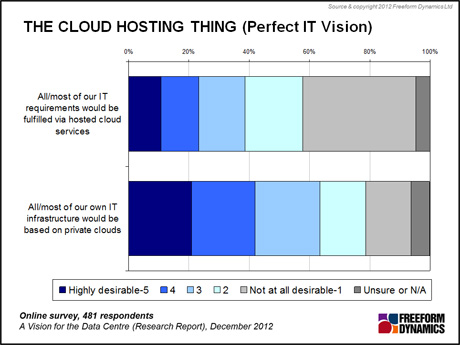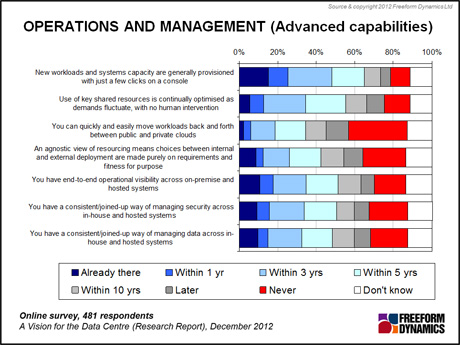By Tony Lock
Datacentres tend to have very long life times and the opportunities to design and build one from scratch are very rare. On the other hand, IT technologies evolve rapidly, so the majority of datacentres are composed of multiple generations of systems. Such complexity comes at a cost, especially in terms of manageability. It can also lead to rigidity, which in turn hampers the ability of IT to respond quickly to new and changing requirements.
Against this background, Freeform Dynamics recently asked IT professionals about their vision for the datacentre, and specifically their views on some of the capabilities that are often put forward by IT vendors to create a more flexible, dynamic and future proof environment. The research explored both the desirability of such capabilities, and the timescale over which they are likely to be introduced, if at all. Let’s walk through some of the more interesting findings.
To the Cloud, or not?
With all of the marketing activity around all things ‘cloud’ the first thing the study sought to clarify was what role ‘cloud services’ are thought to have. The survey asked how desirable the use of cloud solutions would be in a perfect world unconstrained by existing technologies and legacy systems. (Figure 1.)

Figure 1
It is very clear that fewer than a quarter of those surveyed see it as desirable that most of their IT requirements be delivered via services running in the external cloud. Indeed, more than half state using external cloud to fulfil most of their IT services has no attraction at all. Interestingly only a very small number have no opinion on the matter, indicating that there are no halfway positions on external (a.k.a. public) cloud.
Further analysis indicates very small organisations, those with fewer than 10 staff, have least attraction to the idea of cloud offerings dominating IT service delivery. This runs counter to the many pundits who state how desirable ‘cloud’ is to smaller businesses.
Even a wholesale move to internal (a.k.a. private) cloud solutions are not seen as desirable by a majority of organisations. It is therefore doubtful that IT vendors advocating the total switch to such solutions will ever convince the IT community that this is a good idea. In other words, new cloud architectures and services will generally complement rather than completely replace traditional systems and methods – it’s therefore going to be a hybrid world for the foreseeable future, in more ways than one.
The truth, of course, is that cloud computing is really an umbrella term which translates to a whole range of different capabilities when broken down, and most of these are not directly dependent on each other. When you look at things at this level, perceptions are in many cases a lot more positive, so let’s explore this further.
Visions of Operations and Management going forwards
Looking at various aspects of IT operations and management, there is considerable consistency in the functionality professionals would like to possess in the future. (Figure 2)

Figure 2
The research shows how widely appreciated are capabilities with the potential to automate important functions and processes. The fact that almost two thirds of respondents rate the ability to automate service provisioning reflects the rapidity with which business users expect new IT services to be delivered. The slightly greater numbers stating that using automation to optimise resource utilisation highlights recognition of the inability to directly oversee all technical facets of increasingly complex systems. That said, it is still the case that significant numbers see no value in getting hold of such capabilities.
It is worth recognising the equally high attraction reported for unifying management across servers, storage and networking. This result is very much in line with other aspects of this and other research where there is a strong desire to simplify and integrate management tools. It is also reflected in other responses here where organisations indicate they are seeking to facilitate the better working of their IT teams.
The one area where there is a lower level of perceived desirability concerns the use of ‘hybrid clouds’. In part this may be due to the disinterest in ‘external cloud’ solutions discussed above. But it is also likely that many respondents expect public cloud to be utilised only for systems with significantly different requirements from those running on private cloud systems.
Will ‘vision’ become ‘reality’?
As in all professions, ‘visions of the future’ are subject to constant updates, and IT is no exception. The survey asked when some of the visions mentioned above would become reality, to which a surprisingly wide range of answers were given. (Figure 3.)

Figure 3
On the positive side of things it is apparent that many respondents expect several of the capabilities to be reality within three years. This particularly applies to being able to provision new workloads quickly, but this is an area where early adopters of such solutions make up a significant proportion of those answering.
The vision of optimising shared resources automatically as demands vary is met with a degree more scepticism, even though more than a third thinks it will also happen within three years. Whilst early adopters are again well represented here, considerable numbers are unconvinced and think such capabilities will take more than a decade to arrive or may never appear at all.
But overall there is enough evidence here, and amongst the work being undertaken by IT solution vendors to believe that many datacentres in the twenty-twenties will benefit from solutions automating the provision and securing of services. It is also fair to assume that the adoption of tools to optimise IT resources in line with customer /user requirements will be deployed to a significant degree. Developments such as these fit very well with the desire expressed for such solutions in the visions of the future expressed earlier in the study.
But when it comes to hybrid cloud solutions and the tools to enable the management of such systems, considerable numbers doubt they will happen quickly, if at all. Indeed there is doubt whether it will be possible to easily move many workloads between internal and external resources. These results line up with the lack of desirability expressed for such capabilities in figure 2. The likelihood is that internal and external resources will be used as appropriate, but the management of each may remain distinct for some time to come.
Non-technology challenges to datacentre evolution
Data centres are changing, in much the same way they have always evolved. But today there is growing emphasis being placed on optimisation and automation as well as working out the best way to deliver services. As a consequence, there are a few non-technical challenges that must be addressed before the automatically operating, demand-responsive data centre vision highlighted above can come to pass, irrespective of technological advances. Chief amongst these are ‘change management’ and, perhaps much more importantly,’ IT budgeting and service funding’.
Change management has long been a bone of contention in many organisations. No matter how quickly the IT infrastructure can deploy new services, things will only happen with change management approval. Even today, many of the factors slowing down the deployment of services have little to with technical matters but are more likely due to considerations outside the direct control of IT. Add in the additional option of using external cloud resources for some workloads and the need for modification of change management processes, and indeed service funding, is clear.
At the same time, the ability to build an IT infrastructure in which resources are pooled and optimised requires alterations to the typical project budget models used today. Making changes to the way IT is funded is highly political and will not happen without considerable effort. But few organisations have even begun to consider such modifications.
The data centre is evolving rapidly as IT technology advances at a rapid pace. For new developments to be fully exploited there are some process and political elements that require modification. Only with them will the idea visions of the future data centre fully come to pass.

Tony is an IT operations guru. As an ex-IT manager with an insatiable thirst for knowledge, his extensive vendor briefing agenda makes him one of the most well informed analysts in the industry, particularly on the diversity of solutions and approaches available to tackle key operational requirements. If you are a vendor talking about a new offering, be very careful about describing it to Tony as ‘unique’, because if it isn’t, he’ll probably know.






Have You Read This?
From Barcode Scanning to Smart Data Capture
Beyond the Barcode: Smart Data Capture
The Evolving Role of Converged Infrastructure in Modern IT
Evaluating the Potential of Hyper-Converged Storage
Kubernetes as an enterprise multi-cloud enabler
A CX perspective on the Contact Centre
Automation of SAP Master Data Management
Tackling the software skills crunch